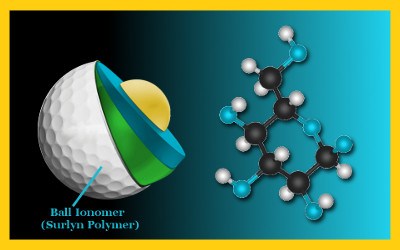
The Effect of Water on a Golf Ball
The most common materials used to make a golf ball cover are either thermoplastic ionomers Iotek‚ Surlyn‚ or thermoset polyurethane (which is more durable). These materials can retain moisture during the manufacturing process and must be kept in humidity-controlled areas. Polymeric materials, depending upon their molecular structure, take up water in varying degrees. Molecular structure as well as temperature affects the way these materials react to moisture. The two final layers or coatings of a golf ball include a primer and a “protective” gloss coating. The primer, in most cases, is water-borne polyurethane and the final layer of protective gloss coat is generally a two-part solvent-based polyurethane. The protective coating is designed to be water permeable. When a golf ball is struck, it creates micro-cracks, allowing for increased passage of humidity/water. To prevent macro cracking , the coating must be designed to allow water to flow freely. The core or “engine” of a golf ball is made out of polybutadiene rubber with proprietary fillers. The rubber is then mixed with fillers, generally inorganic minerals, to increase the overall weight and strength of the core. Although the rubber is resistant to water, moisture will make its’ way to the filler-polymer interface. This moisture inhibits the ability of the filler and rubber to couple. In turn, the ball will not rebound properly, thus affecting distance immensely.
Golf balls do absorb water and the amount of water increases with increasing temperature of the water. Furthermore, there is a measurable decrease in durability and an implied decrease in the elasticity of the core. These results confirm the effect on a golf ball’s distance when the core material gets softer and loses its resilience. Once the water is absorbed into the golf ball, drying of the ball is very slow at ambient temperature. More importantly, even when extreme drying of the ball is attempted at 71°C under vacuum (this should not be tried at home), some moisture remains.
How Water Affects a Golf Ball
“It takes 12 hours for water to penetrate the cover and finds its way to the core. Water channels its way into the core utilizing the fillers as a “highway” and is attracted to the filler-polymer interface. The reduction in coupling between the filler and the rubber will decrease the core‘s ability to rebound or its COR” (Coefficient of Restitution).
To summarize, if you are fishing a ball from the water and know for sure that it has been in the water for less than 12 hours, go ahead and use it.
Play them if you want, just be prepared to live with the consequences. However, playing a ball retrieved from the water will provide you with one thing…a good excuse if you play poorly.





